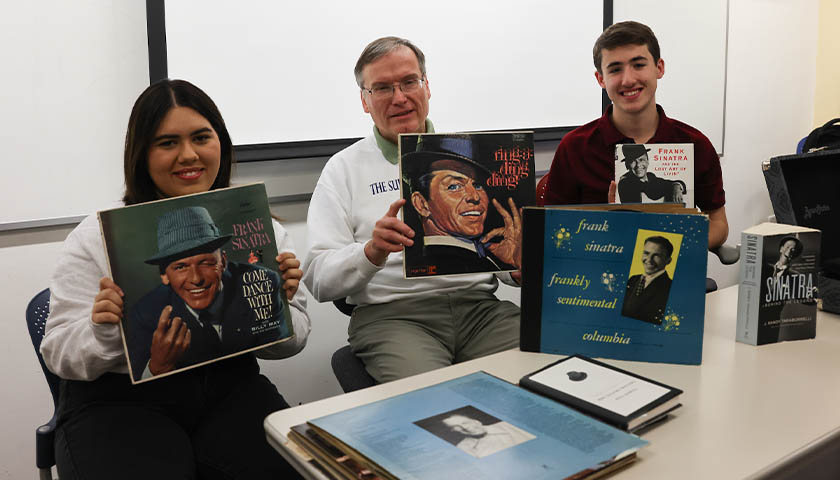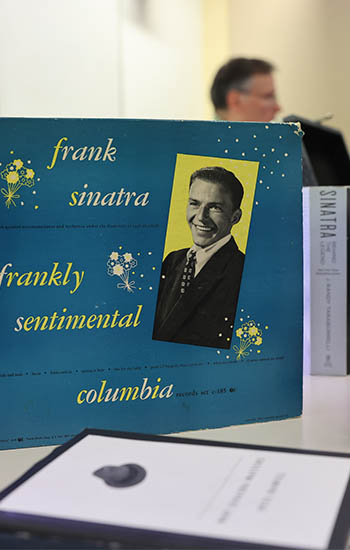They’ve Got Him Under Their Skin

While registering for her fall classes, Elise Ferreira Aidar Coelho did a double take when she stumbled on a first-year seminar called Sinatra: Voice of the 20th Century.
“I’m a big Sinatra fan,” says Ferreira Aidar Coelho, Class of 2026. “As soon as I saw the name of the course, I had to take it.”
And Charlie St. Amand, the quintessential Sinatra buff, had to teach it.
How much of a Sinatra fan is St. Amand? He grew up in a family that revered the singer, and today his Suffolk office is filled with Sinatra memorabilia, including books, posters, records, and his cherished record player. When his oldest daughter, Kristen, was married, father and daughter danced to Sinatra’s 1966 hit “Summer Wind.” (To the guests’ surprise, it was St. Amand who was doing the singing, having, he says, recorded a “good karaoke version” on his wife’s iPad.)
Monday, December 12 would be Sinatra’s 107th birthday, yet to St. Amand it’s no mystery why Ol’ Blue Eyes continues to cast his spell over young listeners. “He left a wonderful body of work that spanned seven decades,” says St. Amand. “Along with the great arrangers and musicians who collaborated with him, he brought a fresh sound to the Great American Songbook.”
Sinatra once said that his most important job as a singer was to bring to the song exactly what the songwriter intended. St. Amand believes that his best dramatic performances came “not only on the silver screen, but in the recording studio and on the concert stage. With his distinctive phrasing, Sinatra made every song his own.”
A former newspaper editor who’s now a practitioner-in-residence in Suffolk’s Communication, Journalism & Media Department, St. Amand decided to offer a Sinatra seminar for the first time this fall. He was inspired in part by the popularity of a Suffolk course titled The Beatles: Here, There and Everywhere, taught for many years by his colleague David Gallant, associate director of the University’s Division of Student Success.
His hunch paid off: When 38 students signed up, St. Amand had to add a second section to accommodate them all.
“Sinatra’s best dramatic performances came not only on the silver screen, but in the recording studio and on the concert stage. With his distinctive phrasing, he made every song his own.”
America’s first pop superstar
Suffolk’s first-year seminars are designed to provide new students with the chance to study a single topic in-depth, in small classes that emphasize critical thinking, research, and lively discussion. St. Amand says his goal is “to expose our students to someone who was much more than the guy who sang ‘My Way’ and ‘New York, New York.’ I want them to learn about his influence beyond music and movies, including in politics and social justice issues. I don’t expect them to become lifelong Sinatra fans, but I want them to appreciate a career that was extraordinary.”
That extraordinary career took off in the late 1930s when Sinatra—the Hoboken, New Jersey–born son of Italian immigrants—joined Harry James and Tommy Dorsey’s big bands as lead singer, and continued until his death in 1998 at the age of 82. Over the course of seven decades, Sinatra became America’s first pop superstar and one of the top-selling recording artists of all time, with such enduring hits as “Night and Day,” “I’ve Got You Under My Skin,” “In the Wee Small Hours of the Morning,” and “Fly Me to the Moon.” He had a second successful career as an actor in film and on television, starring in musicals like On the Town and Pal Joey and earning an Oscar in 1954 for his acclaimed dramatic performance in From Here to Eternity.
Ferreira Aidar Coelho remembers first hearing Sinatra as a young teen, when his songs were played while she and her family were dining at a fine restaurant in her home country of Brazil.
“What caught my attention was the swing and confidence in his voice,” says the print/web journalism major, whose playlist includes Sinatra, along with Taylor Swift, Demi Lovato, and Harry Styles. “I found his lyrics and the way he put words together very calming.”
Michael Najarian, Class of 2026, came to appreciate both Sinatra’s way with a song and his “classy” style and charm. His many love songs, Najarian says, manage to be “similar and different at the same time, and I like the way he always wore nice suits and a fedora.”
During the seminar, St. Amand immersed students in Sinatra’s music and movies, and assigned them readings from Why Sinatra Matters by journalist Pete Hamill. Students worked in groups to research various aspects of Sinatra’s life and the historical context of each decade in which he recorded music—including the era’s politics, economic climate, fashions, and pop culture—and presented their findings to the class.
Najarian and his group turned back the clock to the 1950s, when a loaf of bread cost 12 cents and the majority of cars, like Chevy and Ford, were still American built.
“Some of the information we found was surprising, like how things were so cheap,” says Najarian, a print/web journalism major. “But it made perfect sense because wages were so low at the time.”
Students also learned how Sinatra used his voice to advocate for greater racial and religious tolerance, and his celebrity to associate with presidents from Kennedy to Reagan, as well as with pro athletes, corporate CEOs, and, more controversially, organized crime figures.
Najarian, whose playlist otherwise leans toward rap, rock, and R & B, is a member of Suffolk’s cross country and track & field teams. An aspiring sports journalist, he says the Sinatra seminar has taught him skills that can help him reach his goal: the importance of accuracy in research; the necessity of double- and triple-checking facts; and how to be comfortable speaking to groups. “Sinatra was a unique and influential figure in so many ways,” he says. “I would definitely recommend this course to other students.”
And that is surely music to St. Amand’s ears.
A Sinatra Top 10 From Charlie St. Amand
- “Come Rain or Come Shine” (1961)
- “Summer Wind” (1966)
- “I’ve Got You Under My Skin” (1956)
- “Fly Me to the Moon (In Other Words)” (1964)
- “In the Wee Small Hours of the Morning” (1955)
- “Luck Be a Lady” (1963)
- “Angel Eyes” (1958)
- “Emily” (1977)
- “That’s Life” (1966)
- “Night and Day” (1956)

Contact
Tony Ferullo
Office of Public Affairs
617-573-8448
Greg Gatlin
Office of Public Affairs
617-573-8428



